Temperature
Record Quality Problems or....
Silk Purses and Sow's
Ears
Note: Several links on this general subject at
bottom of page
It is not uncommon to find obvious non-climatic trends in temperature
records that are not related to the growth of the Urban Heat Island (UHI).
These features can be termed inhomogeneities and unless complete station
diaries have been kept it is often impossible to accurately assign causes.
[1] The administration and hardware needed to collect temperature
records were put in place for purposes of weather reporting and forecasting.
NOT to define subtle climate changes. So this whole process of measuring
"climate change" from instrumental records is to some extent trying to make
a silk purse out of a sows ear. Computing climate change from
thousands of temperature records from around the globe is akin to attempting
to make a set of silk travel baggage from a few sacks full of sows ears.
[2] It so happens that the best administered,
most complete and easiest to research records are those from larger towns
and cities where permanent staff may be better trained and motivated to make
more accurate and complete observations and keep records in good shape.
Naturally, any records in growing urban areas will be contaminated to some
extent by artificial warming due to the UHI although inhomogeneities such
as an uncorrected move to the urban fringe can cancel out the UHI component,
see the example of Sydney.
Figure 1 shows the gradation in UHI trends
affecting temperature records from a range of population centres in California.
Graphic thanks to Dr James Goodridge, retired State Climatologist
and Dr. Gary S. Sharp, Center for Climate / Ocean Resources Study,
Monterey, CA.
These divergent trends from California that prove the UHI in large data
sets is similar to the result from South Africa obtained by Hughes &
Balling 1996, who examined records from 1960-1990.
Figure 1
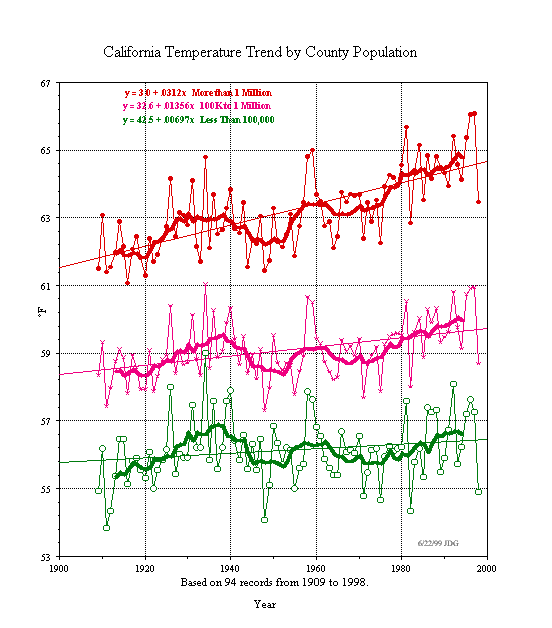
[3] Conversely, records from rural sites are more
prone to have data gaps, site / equipment changes are more likely
to be poorly documented and generally the data are not as easy to work with
as those from cities, Yet, it is in these imperfect records that a truer
definition of the last centuries climate fluctuations will be discovered.
It is not uncommon to find obvious non-climatic trends in temperature
records that are not related to the growth of the Urban Heat Island (UHI).
These features can be termed inhomogeneities and unless complete station diaries
have been kept it is often impossible to accurately assign causes.
In many cases the causes can be due to changes in the immediate environment
of the Stevenson screen ( or other enclosure) that houses the thermometer
or sensor. This is quite separate from the steady rise in temperatures
due to growth in the UHI over entire urban areas.
Additions to buildings might increase the radiation of absorbed solar
radiation to the thermometer enclosure or for example a hedge could be allowed
to grow up, these cases could result in non-climatic warming until site conditions
were restored. Conversely, the clearing of shelter vegetation leading
to increased ventilation or damage to the screen louvres could result
in non-climatic cooling over a period of years.
Two examples are given below, Figure 2 from Orange Post Office in
NSW Australia and Figure 2 from Greenville in North Carolina, USA.
In the case of Orange, a town with a population in the 20-30,000 range
now, the temperature graph shows a large steady warming from 1940
to the 1960's when compared to the neighbouring country towns of Bathurst
and Forbes. This warming looks too rapid to be only due
to UHI growth. Relevant factors are, the Bathurst record was measured
peripheral to the city which is similar in size to Orange. Forbes is
about one quarter the size of Bathurst or Orange and the station is urban.
It is possible that much of this rapid warming in Orange relates to
progessive building changes in the vicinity of the Post Office yard over a
period of twenty or so years from 1940 to the 1960's. In the late
1960's the station moved to Orange Airport and it looks from the record that
improvements were made to the Post Office site from the mid 1960's.
The writer is not aware that Orange Post Office has been used in large area
datasets.
Figure 2

In the case of Greenville, South Carolina, there is a pronounced non-climatic
cooling in the few years around 1904. Note that Jones 1991 (CRU)
did not use that cool period in Greenville. Both sests of Greenville
data have been subject to quality control or statistical tests and this
graph must call into question the adequacy of the GHCN procedures.
Note that non climatic cooling in the early years of these time series
inserts artificial warming into the trend, just as artificial warming in recent
years.
Figure 3
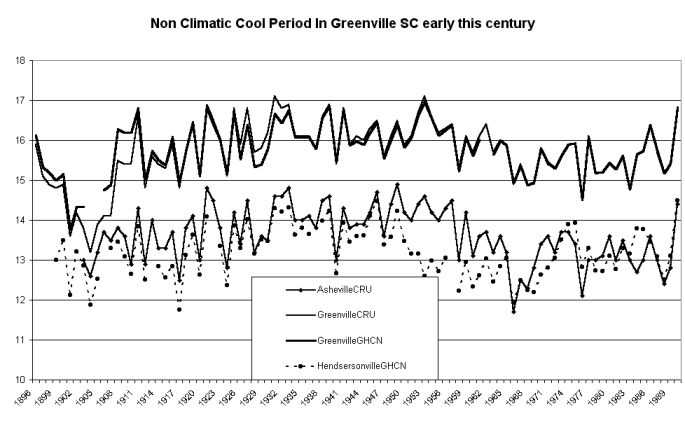
[4] The UHI phenomenon has been well documented
in many scientific papers. The most successful definitions come from
studies of one or a few heat islands using perhaps real time temperature
recording on a particular night or maybe comparisons over years with nearby
rural stations with good quality data. Definition is clearer
too in areas of flat terrain, as opposed to comparisons in hilly terrain
where all manner of microclimatic variations could mask the UHI.
In recent years we have the advantage of seeing the NASA / NOAA images of
UHI's in various sectors of the USA from GOES satellite
land surface infra red data. Remember these images
are snapshots on a particular date, at a time of calm weather.
Obviously during windy conditions the UHI plume will be dispersed.
There is a lot of explanatory information on the Net on the UHI, just use
the search engines, type in heat island or urban heat island and many sites
should be listed. In my view the extensive evidence on the existence
of the UHI in urban temperature records should lead naturally
to an assumption of UHI presence, with only the magnitude to be defined.
The failure of climatology in general to take this position has lead to the
current situation where the concept of century long global warming,
a cornerstone of global economic policy on carbon emissions,
is based on very poor climate data often contaminated by the UHI.
Consider for a moment if positions were somehow reversed and the greenhouse
industry & IPCC wanted to emphasize the UHI; with all the evidence available
they would simply say that the "precautionary principle" dictated that they
accept the existence of the UHI in all urban areas, thus urban records would
not be used in studies of long term climate.
[5] The UHI can be elusive when studies are made on
large datasets and there are many reasons for this, some of which will be
explored below.
- The growth in the HIE with population is not a straight line relationship
but unit increases in population cause smaller increments in the HIE as
population rises.
- Many researchers have assumed very small or negligible UHI in populations
of less than 100,00, yet this is not so. The above bullet point on
a non-straight line relationship to population plus the underestimation of
the UHI in small to medium towns has lead to many studies where city UHI's
are compared to so called rural stations that in fact are towns that have
slightly smaller UHI's. This leads to a result proving the original
UHI to be small because the whole concept of a meaningful comparison
is flawed from the start. See my pages on Atlanta / Macon and Sydney
Australia for examples of this.
- The many data breaks, jumps and steps caused by equipment and site
changes, or non-climatic data drifts due to equipment and site deterioration,
all constitute inhomogeneities that contribute to a blurring of UHI definition
in large datasets.
- A serious and very common factor in recent decades is the general
move from city centers to airports in post WWII years. This
has usually lead to an immediate step down in the graphed record, see Atlanta
in early 1960's for this type of step. So, for a time if the
record remains uncorrected for the move, some UHI has been compensated for
by the step but this is only temporary because airports can be shown to have
vigorously growing UHI's of their own, due to the common industrial expansion
in those precincts in the second half of this last century. See also
link to Sydney Australia above where the Airport UHI has grown faster
than the city.
- Climatic variations between regions, between areas of
high and low topography, between coast and inland can also cause a blurring
of UHI definition in large datasets. A rural area with many rural
records may have been affected by years of subtle micro-climate change due
to land clearing and reduction of forest areas.
More examples of faulty data and non climatic trends in temperature
records will be posted.
Errant Warming Trends in Rural USSR Stations
While working on the recent USSR pages several examples of non-climatic
trends from rural stations have come to light.
Kzyl Zar west of the Lake Balhash grid boxes is probably the most severe.
Figure 3 shows the colossal errant warming in Kzyl Zar of 3
to 4 degrees in 40 years, when differenced to two nearby cities.
It is this sort of errant warming that is making the GHCN rural trend equal
to the trend when urban stations are added, a possibility totally missed by
Peterson et al 1999.
Just look at the magnitude of the abberations in Figs 4, 5, 6 and compare
them to the rate of claimed "global warming".
Figure 4
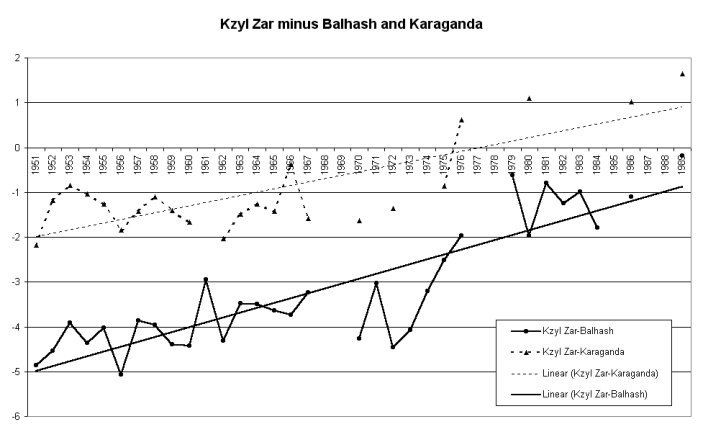
Kokpetky is a rural station east of the Balhash grid box and when diffenced
to two nearby cities, non-climatic warming of 0.5 to 1 degree is seen
in Kokpetky over the 90 years, see Figure 5.
Figure 5
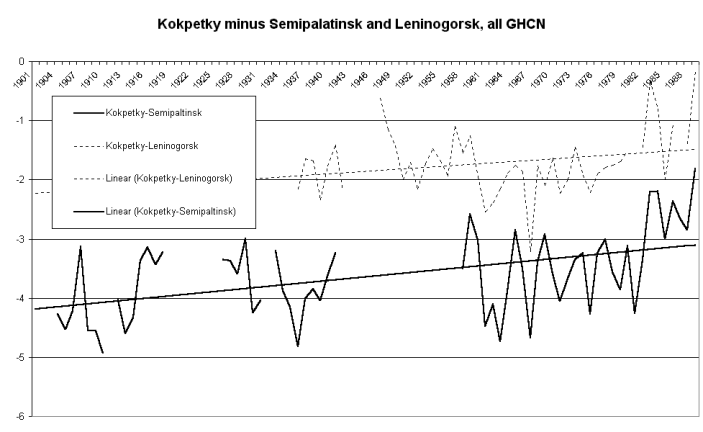
Ekimcan from the SW Sea of Ohotsk grid box is another rural station with
a severe non-climatic warming trend of about 1.5 degrees over 70 years,
see Figure 6.
Figure 6
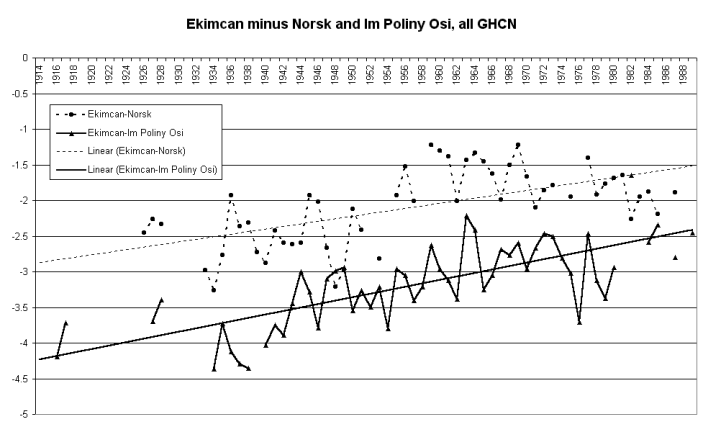
All these USSR examples are from the GHCN, other datsets are probably
similar.
You would have to say that the GHCN statistical tyre kicking process is
pretty ineffective to let these grossly aberrant USSR trends through.
Any comments by the GHCN team or anyone with a relevant contribution can
be posted.
Links to other pages dealing with data quality
USA and USSR inhomogenous data, usually anomalously
warming, from the V2 GHCN
Aberrant data from Peru
Examples of aberrant monthly data entries and worse
found throughout the Jones data
Report comparing record quality in national datasets
above 50 degrees north. Downloadable zipped Word 97 file
New report by Warwick Hughes and Alan McCallum
Data quality as measured by missing months has been computed for stations
above 50 degrees north in three main global data sets, Jones 1991, Jones
1994 and V2 GHCN(adjusted files).
In recent decades station numbers are reduced in most countries, data
is deteriorating in terms of having more missing months and in the area of
the old USSR where problems seem worse, remaining stations are more urban.
Just where the IPCC claim the most warming, in high latitudes, data is getting
worse, stations are closing and not just in Russia.
Anyone needing VBA code writing and work with MS Access queries
should contact Alan McCallum through me.
Download 3.6 MB zip file for MS DOS
of Jones 1994 station by station temperature data
Download 136 KB zip fil4e for MS DOS
of Jones station by station data 1996 update.
You read this first here.
Page updated 11, October, 2000
© 2000 Warwick Hughes,
Back to Front Page





